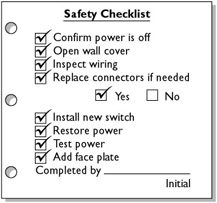Implementing the Quality Policy
|
| < Day Day Up > |
|
The end result of the quality planning is to find a method to implement the quality policy. Because planning is iterative, the quality planning sessions may need, often do require, several revisits to the quality planning processes. On longer projects, there may be scheduled quality planning sessions to compare the performance of the project in relation to the quality that was planned.
Creating the Quality Management Plan
One of the major outputs of quality planning is the quality management plan. This document describes how the project manager and the project team will fulfill the quality policy. In an ISO 9000 environment, the quality management plan is referred to as the “project quality system.”
Exam Watch
ISO 9000 is an international standard that helps organizations follow their own quality procedures. ISO 9000 is not a quality system, but a method of following procedures created internally to an organization.
The quality management plan addresses three things about the project and the project work:
-
Quality control Work results are monitored to see if they meet relevant quality standards. If the results do not meet the quality standards, the project manager applies root cause analysis to determine the cause of the poor performance and then eliminates the cause. Quality control is inspection orientated.
-
Quality assurance The overall performance is evaluated to ensure the project meets the relevant quality standards. Quality assurance maps to an organization’s quality policy and is typically a managerial process. Quality assurance is generally considered the work of applying the quality plan.
-
Quality improvement The project performance is measured and evaluated, and corrective actions are applied to improve the product and the project. The improvements can be large or small depending on the condition and the quality philosophy of the performing organization.
Identifying the Operational Definitions
Operational definitions, also known as metrics, are the quantifiable terms and values to measure a process, activity, or work result. An example of an operational definition could be an expected value for the required torque to tighten a bolt on a piece of equipment. By testing and measuring the torque, the operational definition would prove or disprove the quality of the product. Other examples can include hours of labor to complete a work package, required safety measures, cost per unit, and so on.
Operational definitions are clear, concise measurements. Designating that 95 percent of all customer service calls should be answered by a live person within 30 seconds is a metric. A statement that all calls should be answered in a timely manner is not.
Applying Checklists
Checklists are simple approaches to ensure work is completed according to the quality policy. It’s usually a list of activities that workers will check off to ensure each task has been completed. Checklists can be quick instructions of what needs to be done to clean a piece of equipment, or questions that remind the employee to complete a task: “Did you turn off the printer before opening the cover?”

|
| < Day Day Up > |
|
EAN: 2147483647
Pages: 209